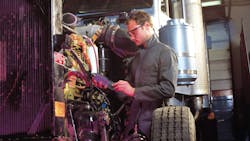Recommendations for more effective maintenance scheduling - part 1
An essential component to any successful fleet maintenance operation is the planning and scheduling of all work. The objective is to have high wrench time and shop productivity.
A best practice is to identify each place where work is done – shop bays, in the field, wash racks, fuel islands, etc. – and assign resources to each location where jobs are done.
Once jobs are scheduled, the key is to stay on schedule. This encompasses:
- Knowing when you are behind schedule so you can intervene before the end of the shift or day.
- Escalating a schedule miss condition within that interval so that it can be corrected. If a job stays behind, a higher level of resources need to be brought to bear.
In a typical shop, it is not known what jobs are behind until the report comes out. But by then, it is too late to fix.
Here are some tips to help with scheduling maintenance:
1. Identify and assign unique names/codes to all of the areas where work takes place.
2. Design a priority system that will divide work orders into categories.
3. Follow through on systematic assignment of labor standards. Establish milestones for jobs that take more than four hours. Create a database of the standards.
4. Physically build a scheduling board or two – perhaps using a Plexiglas sheet with the permanent information (time and work areas) drawn on a blue print behind it. List the work areas across the top and time down the edge. If 1/2” is 30 minutes, then a 48”-high schedule will cover eight shifts.
Every two or four hours add a heavy line to the board horizontally. Build a straight edge that can travel up and down the schedule to indicate the current time of day.
5. Review all jobs ready to go. Add a labor standard if this is not done already.
Add 10 percent (or some other allowable lost time factor) to the labor standards for scheduling purposes. This allows some slippage without redoing the physical schedule. The work order should have the actual standard on it.
6. Load jobs (write down on the scheduling board with a grease pencil), starting with those of the highest priority. Chose a work area for the repair and a starting time. The elapsed time will depend on 110 percent of the labor standard.
As you load the schedule, balance the crewing requirements. If you experience frequent emergencies, leave a percentage (equal to your historical emergency hours) of your crew’s time unscheduled.
Alternatively, leave certain crew members off the schedule when you start up. These workers can be assigned to interruptible jobs.
7. The schedule should be updated every two to four hours to visually reflect the actual status of all jobs. Red flags can be used when jobs fall behind.
8. If you use two scheduling boards, fill the second one with jobs due in the next week. When the next week starts, the board will be up-to-date and ready to go.
If you are running one board, keep erasing jobs as they are completed and start loading future jobs.
9. The checks, occurring every two or four hours, should be coordinated with breaks and lunch. If the work day runs from 7 AM to 3:30 PM, checks might be set for at 9 AM, 11:30 AM and 2 PM.
At the two-hour check, all jobs should be evaluated for their status relative to the schedule. Any jobs noted as complete on the schedule should actually be complete.
Milestones should be met on longer jobs. Shorter jobs that span a check might be informally reviewed.
My next column will continue the discussion of successful maintenance scheduling. It will provide guidance on how to help make sure jobs get done according to what has been scheduled and what to do when deadlines are not met.
Joel Levitt is director of international projects for Life Cycle Engineering (www.lce.com), an organization that provides consulting, engineering, applied technology and education solutions that deliver lasting results. Previously, he was president of Springfield Resources (www.maintenancetraining.com), a management consulting firm.
About the Author

Joel Levitt
President, Springfield Resources
Joel Levitt has trained more than 17,000 maintenance leaders from more than 3,000 organizations in 24 countries. He is the president of Springfield Resources, a management consulting firm that services a variety of clients on a wide range of maintenance issues www.maintenancetraining.com. He is also the designer of Laser-Focused Training, a flexible training program that provides specific targeted training on your schedule, online to one to 250 people in maintenance management, asset management and reliability.
